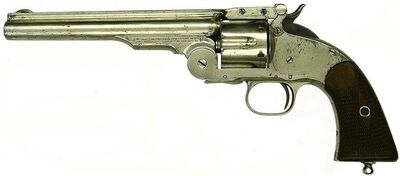
Schofield revolver
The Schofield Revolver was a top break single action revolver produced by Smith and Wesson.
History[]
In 1870, the United States Army adopted the 44 calliber Smith and Wesson American top break revolver, being the first standard issue cartridge firing revolver. Most military pistols up until that point were black powder/cap and ball revolvers, which were (by comparison) slow, complicated, and susceptible to the effects of wet weather.
In 1875, Major George Schofield improved the revolver by adding a new locking system to make the gun easier to load for a mounted trooper. The new revolvers with the locking system became known as "Schofields." The US Army adopted the new revolver but also purchased Colt Peacemakers from Colt. Major Schofield had patented his locking system and earned a payment on each gun that Smith and Wesson sold.
The Schofield had several advantages over the Peacemaker, with its top-break action empty cartridges could be ejected and loaded in 26 seconds, while a Colt had to have its cartridges ejected once at a time through a ejector rod.
Later, the Army made a request for Smith and Wesson to produce the revolver in .45 Colt, the standard issue cartridge of the time. Instead, Smith and Wesson made their own shorted cartridge, the .45 Schofield. The Schofield could fire the .45 Schofield but not 45 Colt, as it was too long. The Colt Peacemaker fired both cartridges easily. The US Army would adopt the 45 Schofield, but old stocks of .45 Colt still remained, and US soldiers would sometimes receive the wrong ammunition for their Schofields. This forced the US Army to drop a number of the revolvers from service.
Smith and Wesson themselves began to work on new top break revolvers so they would not have to pay Major Schofield for his patent. In 1878 Smith and Wesson introduced the New Smith and Wesson model 3 revolver.
Major Schofield would later be given a court martial, which some believe was because of the money he claimed from his gun. His wife would also soon die of natural causes. In 1880, Major Schofield would commit suicide, using one of his own guns.
Usage[]
The Schofield saw action in the Indian wars, and some were even used right up into the Spanish American and Philippine–American Wars in the 1890s.
It was believed that a few Schofield's may of been at the Battle of the Little Bighorn in 1876.
Towards the end of the 19th century, the US Army began selling off their old stock of revolvers. Old Schofields in storage were nickel plated, the barrel reduced in size and sold on the market. Wells Fargo purchased many old Schofields. These revolvers were then inspected by Wells Fargo armorer and uniquely stamped "W.F. & Co" or "Wells Fargo & Co", along with the original Smith & Wesson serial number re-stamped alongside the Wells Fargo stamping on the flat part of the barrel just forward of the barrel pivot as well as re-stamping any part of each revolver which had not originally been stamped or stamped in a location that would be difficult to view the serial number, when needed.
The Wells Fargo Schofield revolvers became so popular with collectors from the 1970s onwards that the unique Wells Fargo markings were being "counterfeited" or "faked" by unscrupulous sellers to enhance the value of other similar versions that had not been genuinely owned by Wells Fargo & Co. There are more "fake" Wells Fargo marked Schofield revolvers than genuine ones in existence and, accordingly, a collector interested in purchasing a "Wells Fargo" Schofield revolver would be well advised to have a pre-purchase inspection and verification performed by an expert who specializes in this model.
The Schofield was used by a number of notable individuals, including Western outlaws and lawmen, such as Jesse James, John Wesley Hardin, Pat Garrett, Theodore Roosevelt, Virgil Earp, Billy the Kid, and many others.